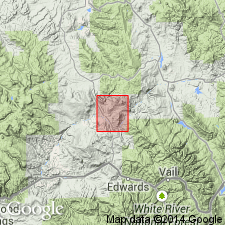
- Usage in publication:
-
- Rock Creek conglomerate member
- Modifications:
-
- Areal extent
- Dominant lithology:
-
- Conglomerate
- Sandstone
- AAPG geologic province:
-
- Eagle basin
Summary:
Pg. 1864. Rock Creek conglomerate member of Maroon formation. Whole thickness consists of pink to red coarse sandstone and arkosic grits and conglomerates highly cross-bedded. Lower part contains a few thin interbedded gray shales and limestones. Thickness approximately 1,224 feet. Underlies State Bridge siltstone member (new); conformably overlies McCoy formation. Age is Permian(?).
Name credited to H.F. Donner, 1936 (Univ. Michigan unpub. PhD dissert.) [see entry under Donner, H.F., 1949, GSA Bull., v. 60, no. 8, p. 1215-1248].
Source: US geologic names lexicon (USGS Bull. 1200, p. 3306).

- Usage in publication:
-
- Rock Creek conglomerate member†
- Modifications:
-
- Abandoned
Summary:
Pg. 1223. †Rock Creek conglomerate member of McCoy formation. Abandoned. Beds included in [unnamed part of] McCoy formation of Pennsylvanian age in McCoy area. Derivation of name given.
Named for its fine exposures along west bank of Rock Creek north of McCoy, in Eagle and Routt Cos., northwestern CO.
Source: US geologic names lexicon (USGS Bull. 1200, p. 3306).
For more information, please contact Nancy Stamm, Geologic Names Committee Secretary.
Asterisk (*) indicates published by U.S. Geological Survey authors.
"No current usage" (†) implies that a name has been abandoned or has fallen into disuse. Former usage and, if known, replacement name given in parentheses ( ).
Slash (/) indicates name conflicts with nomenclatural guidelines (CSN, 1933; ACSN, 1961, 1970; NACSN, 1983, 2005, 2021). May be explained within brackets ([ ]).

